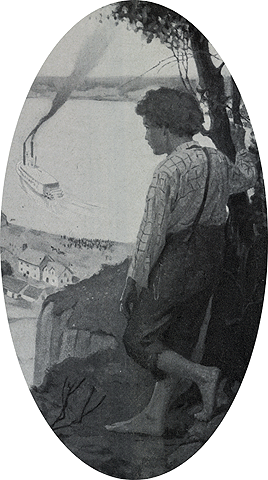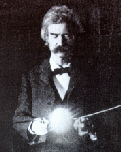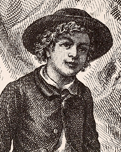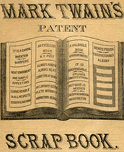CLICK TO ENLARGE
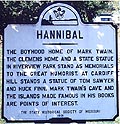
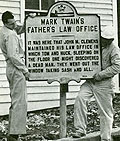
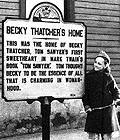
|
As MT grew older, his fictional
representations of Hannibal grew streadily bleaker. In his
last great story, for example, the man who corrupts the
village of Hadleyburg sarcastically warns someone that if
he doesn't reform, he "will die and go to hell or
Hadleyburg" -- and adds that hell would be a better place
to end up. Indeed, except for Tom Sawyer, MT's
fiction is typically anti-nostalgic: through realism,
satire, burlesque and occasional invective he repeatedly
attacks the hold that idealizations of the past have on the
mind of his time, whether that past is embodied in Arthur
or Elizabeth's England, Scott or Cooper's historical
romances, or the many villages, including St. Petersburg,
that Huck Finn keeps running away from.
MT's American audiences, on the other
hand, have become very attached to the image of Hannibal as
Tom's St. Petersburg. In Tom Sawyer generations of
readers have found access not just to childhood as a realm
of summertime adventures, but to a mythic "once upon a
time" in the national past, a place before the disruptions
of industrialization, urbanization and immigration that
were already beginning to transform the face of America
even when MT's novel first appeared.
After he ran away from Hannibal in the
mid-1850s, Sam Clemens seldom returned. But MT's readers
have returned again and again, in spirit and in person, to
what in "Old Times on the Mississippi" MT called the "white
town drowsing in the sunshine." When they come in person
they're called tourists, whose presence turns nostalgia
into a marketable commodity. In 1955, according to the
National Geographic article below, Hannibal
had more annual visitors than Hawaii, putting lots of real
people to work in the space of "Tom Sawyer's
playground."
How America has sought its past in Sam
Clemens' childhood home is the story you can explore
through the materials below. As you do that, it's
important also to keep in mind the sights you won't
see in these texts, photos and illustrations. Injun Joe,
for example, is barely visible as a figure in the landscape
of this earlier America, and the existence of slavery
(except for the first description below) has been
completely erased. The house where "Becky Thatcher" lived
is marked on all the maps, but there are as yet no markers
for the haunted house in Dawson's Landing (as Hannibal is
called in Pudd'nhead Wilson) to which another of
MT's Toms, "Tom Driscoll," snuck out at night to meet with
his mulatto mother Roxy. As a shrine, either to MT's
achievement or to America's history, "Hannibal," like that
famous fence around Aunt Polly's house, has been
white-washed.
|


